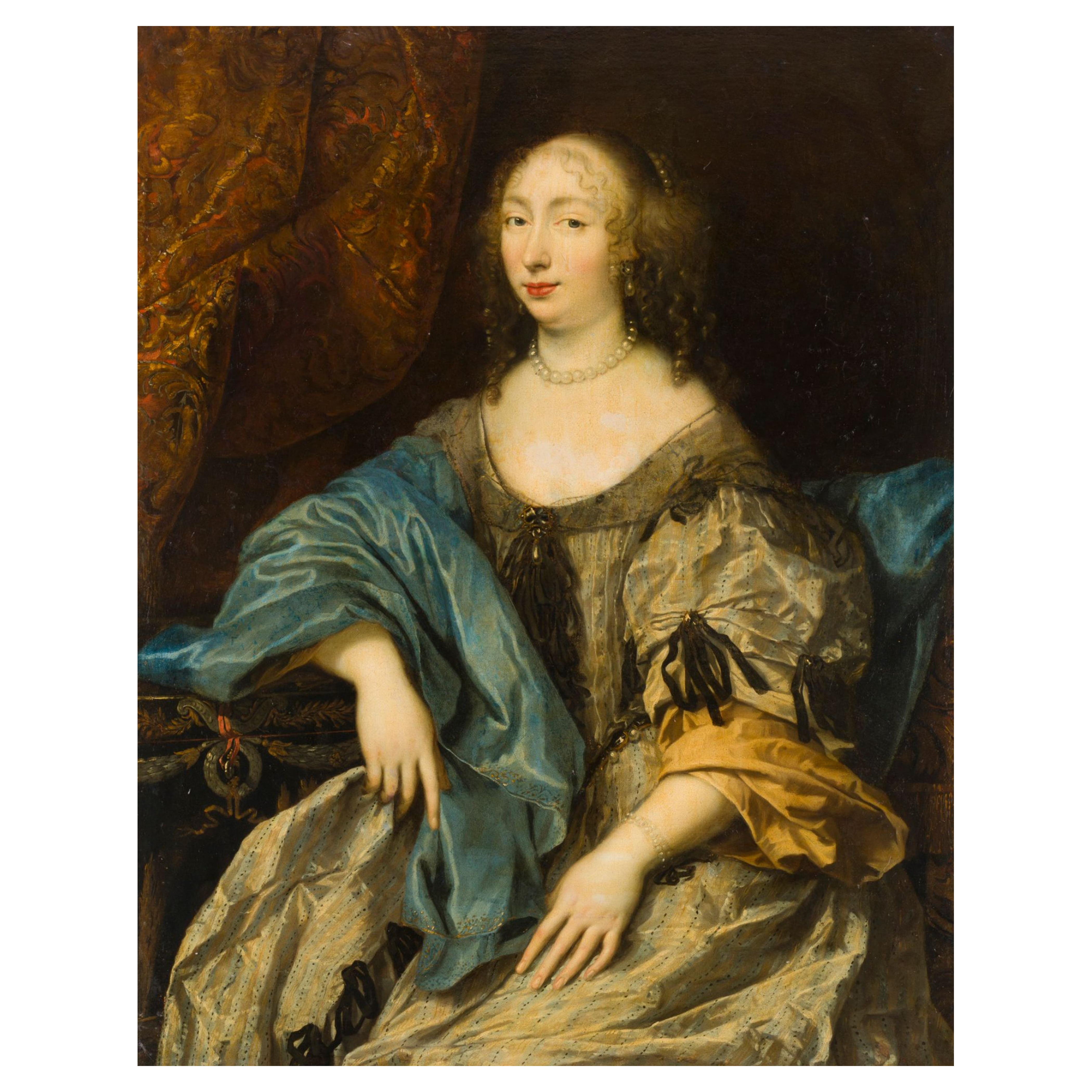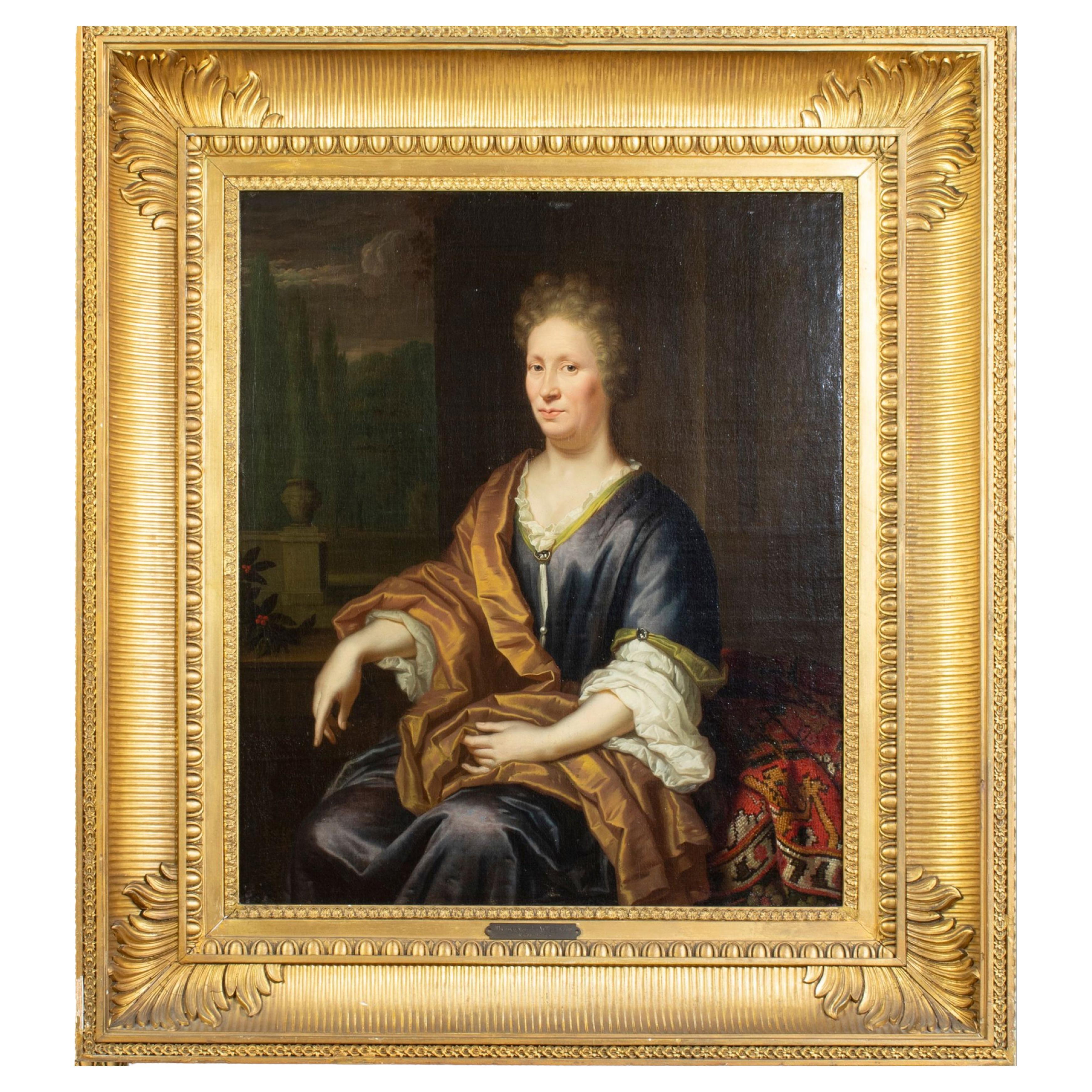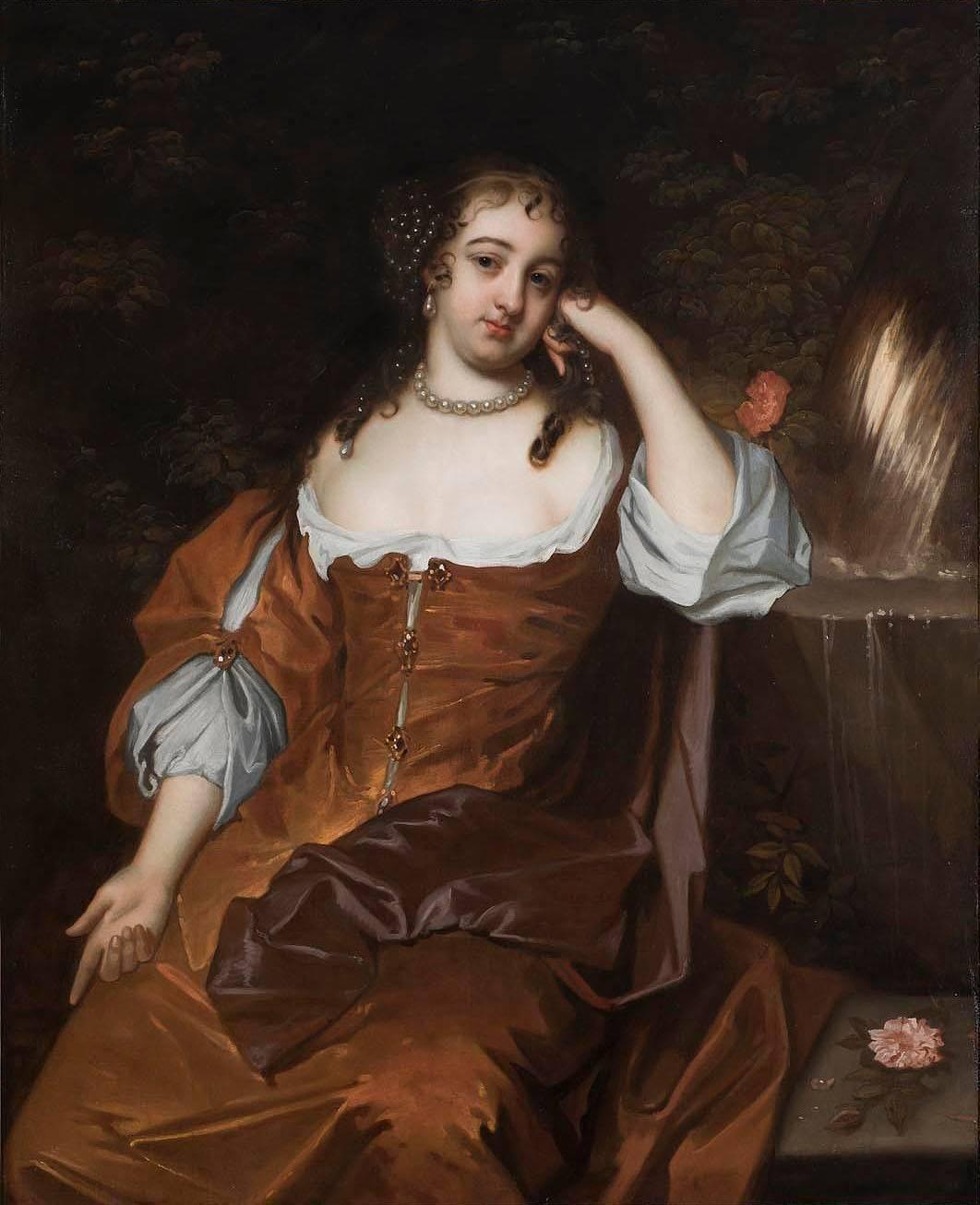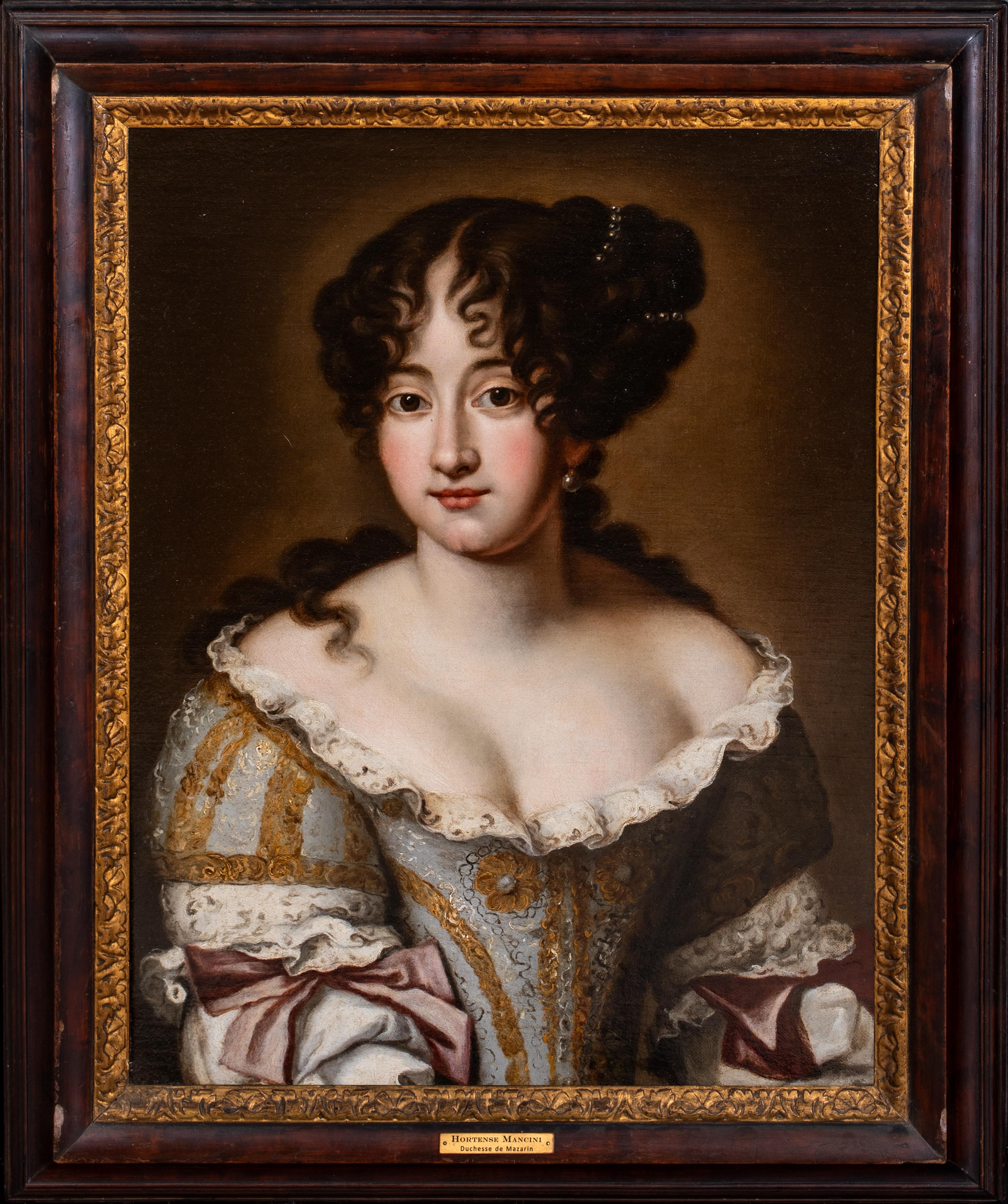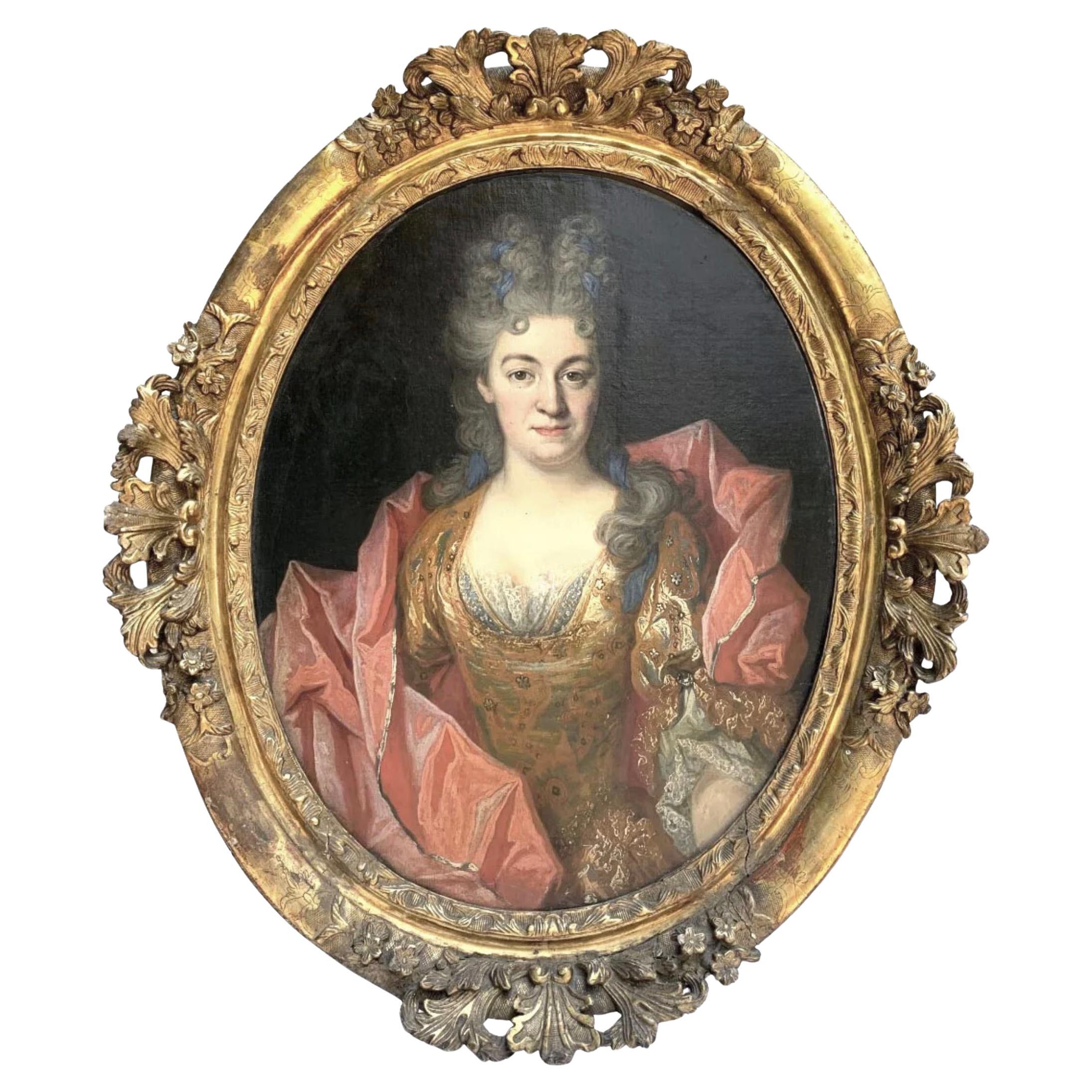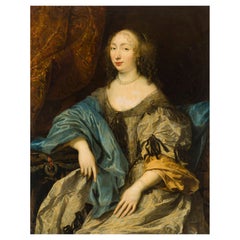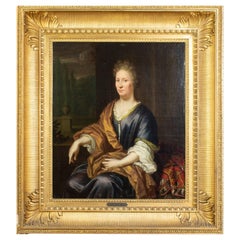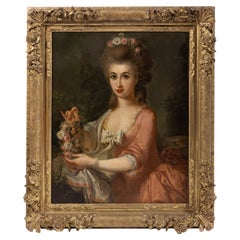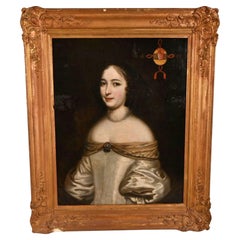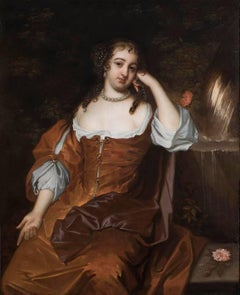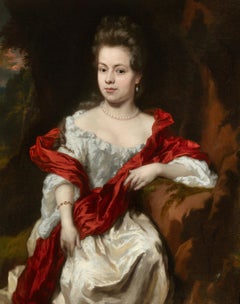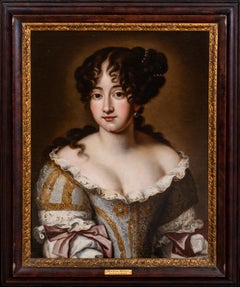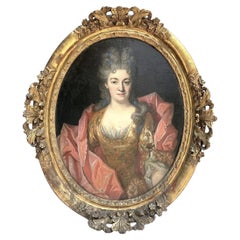Items Similar to Reinier de la Haye (1640-1695) - PORTRAIT OF A LADY IN FRONT OF A PARK LANDSCAPE
Want more images or videos?
Request additional images or videos from the seller
1 of 9
Reinier de la Haye (1640-1695) - PORTRAIT OF A LADY IN FRONT OF A PARK LANDSCAPE
$8,839.67
£6,658.03
€7,500
CA$12,190.28
A$13,695.24
CHF 7,155.78
MX$167,156.78
NOK 90,857.54
SEK 85,523.23
DKK 57,087.15
About the Item
Reinier de la Haye (1640-1695) - PORTRAIT OF A LADY IN FRONT OF A PARK LANDSCAPE Signed R. de la Haye on the right on the architectural base. Seated figure of a noble lady, dressed in red, with a good assortment of jewels, one hand resting on a balustrade on which stands a vase with a bouquet of flowers. To the left, in the background, a park landscape, presumably belonging to the lady's property. Oil on canvas. 45 x 37.5 cm.
Reinier de La Haye was born in The Hague around 1640 as the son of Hendrik de La Haye and Adriana Smulders. He was trained by the leading portrait painter Adriaen Hanneman, and in 1662 he was as member of the Guild of St Luke, suggesting he was working as an independent master by then. He moved to Utrecht around 1669, where he became a member of the guild in that year, and from 1672 to 1674 he worked in Antwerp.
De La Haye painted a small number of still-lifes, elegant genre scenes and equally elegant portraits of members of the upper echalons of society. Unlike his teacher Hanneman, who painted life size portraits, De La Haye generally produced small portraits, meticulously painted, which were increasingly favoured towards the end of the seventeenth century. Surviving portraits by De La Haye are comparatively rare and show his great talent at depicting rich silks and fabrics.
Paintings by De La Haye are preserved in many leading museums all over the world, including the Centraal Museum in Utrecht, the Museum der Stadt Gotha and the Staatliches Museum in Schwerin.
- Creator:Reinier De La Haye (Artist)
- Dimensions:Height: 17.72 in (45 cm)Width: 14.77 in (37.5 cm)Depth: 2.76 in (7 cm)
- Style:Baroque (Of the Period)
- Materials and Techniques:Paint,Oiled
- Place of Origin:
- Period:
- Date of Manufacture:17th century
- Condition:Wear consistent with age and use. very good condition.
- Seller Location:Madrid, ES
- Reference Number:1stDibs: LU5779245106112
About the Seller
4.8
Platinum Seller
Premium sellers with a 4.7+ rating and 24-hour response times
Established in 2005
1stDibs seller since 2021
364 sales on 1stDibs
Typical response time: 1 hour
- ShippingRetrieving quote...Shipping from: Madrid, Spain
- Return Policy
Authenticity Guarantee
In the unlikely event there’s an issue with an item’s authenticity, contact us within 1 year for a full refund. DetailsMoney-Back Guarantee
If your item is not as described, is damaged in transit, or does not arrive, contact us within 7 days for a full refund. Details24-Hour Cancellation
You have a 24-hour grace period in which to reconsider your purchase, with no questions asked.Vetted Professional Sellers
Our world-class sellers must adhere to strict standards for service and quality, maintaining the integrity of our listings.Price-Match Guarantee
If you find that a seller listed the same item for a lower price elsewhere, we’ll match it.Trusted Global Delivery
Our best-in-class carrier network provides specialized shipping options worldwide, including custom delivery.More From This Seller
View All17th Century French School, Workshop of Jean Nocret "Portrait of a Woman"
By Europa
Located in Madrid, ES
17th-century French School, workshop of Jean Nocret
Portrait of a Woman with a Desk
Canvas (Antique Restorations)
107 x 84.5 cm
Good condition
A student of Jean Le Clerc, a Lorrain...
Category
Antique 17th Century French Baroque Paintings
Materials
Paint
Thomas VAN DER WILT (1659-1733) "Portrait of Noble Woman"
By Europa
Located in Madrid, ES
Thomas VAN DER WILT (1659-1733) "Portrait of Noble Woman",
oil on canvas
55cm x 46cm without frame
65cm x 56cm with frame
very good conditions
Thomas van der Wilt (1659–1733) was an...
Category
Antique Early 18th Century Dutch Baroque Paintings
Materials
Paint
FRENCH SCHOOL "Portrait of a Girl with Flowers". 18th Century
By Europa
Located in Madrid, ES
FRENCH SCHOOL
"Portrait of a Girl with Flowers".
Oil on canvas from the 18th century.
Relined.
Dimensions: 80 x 64 cm
Good condition
Category
Antique 18th Century French Baroque Paintings
Materials
Paint
French School 17th Century"Portrait with Coat of Arms Margueritte de Boutteville
Located in Madrid, ES
French School of 1659 17th century
"Portrait with Coat of arms of Margueritte Pierre de Boutteville"
around 1659
Oil on canvas with coat of arms and dated top right Provenance:
Bel...
Category
Antique 17th Century French Baroque Paintings
Materials
Paint
Important English School " LADY HAMILTON " 18th Century Sign
By Europa
Located in Madrid, ES
Important English School " LADY HAMILTON " 18th Century
Oil on canvas, 18th century English school.
Signed.
Small defects.
Dim.: 124 x 99 cm
good conditions
Category
Antique 18th Century English Baroque Paintings
Materials
Paint
Flemish School of the 17th century "Portrait of a Child"
Located in Madrid, ES
Flemish School of the 17th century
"Portrait of a Child"
Oil on canvas
label on the back with coat of arms
77.5 x 63 cm without frame
85.5 x 71 cm with frame
good condition
Category
Antique Early 17th Century Dutch Baroque Paintings
Materials
Paint
You May Also Like
Portrait of a Lady, 17th Century Flemish Oil Old Masters
By Jacob Huysmans
Located in London, GB
Jacob Huysmans
Flemish 1633 - 1696
Portrait of a Lady
Oil on canvas
Image size: 49 x 40 ¼ inches
Gilt frame
Huysmans was born in Antwerp and came to England during the reign of Charles II where he became one of the fashionable painters of the court.. The diarist Samual Pepys noted the artist as capable of a more exact likeness than Lely. Certainly the diarist records that by August 1664 in the circle of Queen Catherine...
Category
17th Century Old Masters Portrait Paintings
Materials
Canvas, Oil, Acrylic
Portrait of Noble Lady
By Nicolaes Maes
Located in New Orleans, LA
Signed and dated "N MAE / 1691" (lower right)
Oil on canvas
A masterful example of 17th-century Dutch portraiture, this magnificent oil on canvas comes alive with luminous color, dramatic contrast and extraordinary detail. The work was composed by Nicolaes Maes, an artist widely regarded as the most prominent portrait painter of his era in Amsterdam. Fashionably styled, Portrait of a Noble Lady exemplifies the mature style of Maes, executed with the same artistry and attention to detail he imparted on his most important private commissions.
This work by Maes comes from the second half of his career and follows in the rich tradition of the great Flemish Baroque painters Peter Paul Rubens and Anthony van Dyck. Like these artists, Maes excels at not only capturing his subjects with a technical perfection but also their inherent elegance and grace. The sitter is draped in luxurious white and red silks and pearls, underscoring the importance and prosperity of his wealthy clientele. She is placed against a dark backdrop, enabling a striking chiaroscuro effect characteristic of the artist’s portraits.
Maes’s immense talent for detail and composition is clearly evident. In both palette and proportion, it embodies the somewhat austere style preferred by the artist, which emphasized a painstaking study of the costumes, hairstyles and accessories of his subjects. Such elaborate and highly detailed costuming in portraiture was a fashionable way to show one's wealth in the 17th century, particularly among the emerging class of wealthy merchants. Similar works by the painter can be found in the Rijksmuseum (Amsterdam), National Gallery (London), National Gallery of Art (Washington, D.C.), Metropolitan Museum of Art (New York) and Philadelphia Museum of Art, among others.
Nicolaes Maes was born in Dordrecht in 1634 to a prosperous cloth merchant. Around 1848, he moved to Amsterdam to study under Rembrandt for several years before returning to his native Dordrecht, where he established himself as a painter of genre scenes and portraits. In the 1650s, Maes traveled to Antwerp where he studied the work of Flemish artists such as Peter Paul Rubens, Anthony van Dyck and Jacob Jordaens...
Category
17th Century Baroque Portrait Paintings
Materials
Canvas, Oil
Portrait of Hortense Mancini, Duchess of Mazarin (1746-1699), 17th Century
By Jacob Ferdinand Voet 1
Located in Blackwater, GB
Portrait of Hortense Mancini, Duchess of Mazarin (1746-1699), 17th Century
by Jacob Ferdinand Voet (1639-1689)
Large 17th Century Italian portrait o...
Category
17th Century Portrait Paintings
Materials
Canvas, Oil
$7,041 Sale Price
35% Off
Circle of Nicolas de Largillière 1656 -1746 Portrait of a Noble Lady
By (circle of) Nicolas de Largillierre
Located in Rio De Janeiro, BR
This striking oval portrait, attributed to the circle of Nicolas de Largillière, exemplifies the refined elegance and artistic sophistication of late 17th to early 18th-century Frenc...
Category
Antique Late 17th Century French Baroque Paintings
Materials
Canvas
Portrait of D. Maria Bárbara De Bragança, Circle of Louis-Michel Van Loo
By H. van Loon
Located in Lisboa, PT
PORTRAIT OF D. MARIA BÁRBARA DE BRAGANÇA (1711-1758), QUEEN OF SPAIN
Circle of Louis-Michel van Loo (1707-1771)
Oil on canvas
Her Royal Highness, the Infanta Maria Barbara of Braganza (1711-1758) was the first-born child of King John V of Portugal (1689-1750) and his queen consort Maria Anna of Austria (1683-1754). Born in December 1711, she had the Convent Palace of Mafra built in her honour following a vow made by her royal father. Her status as Princess of Brazil, inherent to 18th century Portuguese presumptive heirs, would however be superseded once the queen gave birth to two male princes, D. Pedro (1712-1714) and D. José (1714-1777), preventing her from ascending to the throne.
Daughter of one of the most illustrious monarchs of his time, Maria Barbara was carefully educated to become a fond admirer of the arts, and of music in particular, having had the Italian composer Domenico Scarlatti (1685-1757) as her music teacher.
On the 10th January 1723 the young princess was betrothed to the Infante Ferdinand of Spain (1713-1759), eldest son of King Philip V (1683-1746). Six years later, on the 19th January, she entered her new country in a carefully choreographed ceremony that became known to history as the “Exchange of the Princesses”. This unique event took place on a specially built Bridge-Palace, a wooden, luxuriously decorated structure that included various modules and rooms, on both banks of the river Caia, the natural border between the town of Elvas in Portugal and of Badajoz in Spain. Simultaneously, on the same day that the Portuguese Infanta crossed the border to marry the Spanish Crown Prince, her new sister in law, the Infanta Mariana Victoria of Bourbon (1718-1781), her husband’s sister, crossed the same bridge in the opposite direction to marry Prince D. José, the Portuguese heir to the throne.
Once married, Maria Barbara would spend 17 years as Princess of Asturias, only becoming Queen of Spain at her husband’s accession following the death of Philip V in 1746. She is portrayed in the 1743 painting by Louis-Michel van Loo (1707-1771) now in the Prado Museum, in which Philip V had himself represented with all his close family.
The new Queen would take an important role at court eventually becoming the liaison between her husband and the King of Portugal, particularly throughout the negotiations for the Treaty of Madrid (1746-1750). Maintaining her interest in music, she patronized the Italian castrato singer Farinelli (1705-1782) while remaining close to her old master Scarlatti, having herself composed some sonatas for a large orchestra. She would also commission and fund the building of the Royal Salesians Monastery complex in central Madrid, where both her and Ferdinand VI are buried.
The portrait we are presenting for sale shows the Queen in half-length, turning left at three quarters. She is wearing a blue low-cut dress embroidered with flowers and foliage, over a lace cuffed white blouse, and an ermine cloak pined on the left-hand side by a diamond broach. The powdered hair style is held sideways by a seven diamond and black plume headdress and topped by a small gold and pearl crown. The right arm rests on a cushion while the left hand, at chest height, holds a miniature male portrait.
The Infanta’s features are analogous to the 1725 portrait by the painter Domenico Duprà (1689-1770), also in the Prado Museum collection. Further similarities can be found in another portrait by Louis-Michel van Loo, in which a seven diamond and black plume headdress is also present. In this work, the cushion supporting Maria Barbara’s right arm has also some obvious similarities to our painting. The same diamond headdress reappears in Van Loo’s above-mentioned portrait of Philip V’s family dated from 1743.
It is nevertheless in Lisbon’s Ajuda National Palace that it is possible to find an almost identical depiction of the Infanta holding a miniature portrait of her husband. In it, the future Ferdinand VI is portrayed facing right at three quarters and wearing a curly wig, suit of armour, the golden fleece insignia and a blue band, in a composition that closely resembles an 18th century Spanish school painting that appeared in the art market in January 2016.
Another detail common to various portraits of the Portuguese Infanta and Queen of Spain is the small gold and pearl crown on her head. In another Van Loo painting, also from the Prado Museum, in which Maria Barbara is portrayed as Queen, this crown is represented together with a headdress similar to the one previously described. Another two paintings by the same artist, at the Royal Academy of Saint Ferdinand, include the same ornament.
We must also refer the paintings by the artist Jean Ranc (1674-1735). In one, dating from 1729 (Prado Museum), the Infanta is depicted outdoors holding a flower bouquet and wearing a yellow silk dress with red cloak, and a set of diamond and ruby jewellery that includes a headdress similar to the one present in our portrait. Another work by the same artist, belonging to the Complutence University of Madrid, depicts the Infanta sumptuously dressed in identical colours to our painting and wearing an elaborate headdress and diadem.
These portraits, beyond their iconographical importance as contemporary records of the Infanta and Queen Maria Barbara, are also illustrative of 18th century fashion for jewelled head dressing. Often, flowers were combined with joyful adornments, composing almost theatrical displays that would reinforce the ostentatious nature of the image. The ornamental flowers and the chromatic character of the jewels would complement the luxury of the colourful dresses in blue, crimson, green or other silk shades, in compositions whose sole purpose was to highlight a royal sitter’s wealth and power, becoming an essential statement accessory within the strict court protocols and codes of conduct.
Circle of Louis-Michel van Loo (1707-1771)
Slowly but steadily, the resolute, tranquil and dignified attitude of Renaissance and Baroque portraiture becomes artificial and presumptuous. Mid 18th century society favours elusive expression and psychological deepness, albeit limited to the face, that, with emphasis on detail, on the rich colour palette and on changing costumes and landscapes, associated to the courtliness of gestures, creates a strongly artificial environment while maintaining a highly poetic intrinsic character.
Louis-Michel van Loo followed a dynasty of famous Dutch origin artists that had settled in France. Initially taught by his father, Jean-Baptiste von Loo (1684-1745), the younger van Loo studied in Turin and Rome and frequented the Paris Academy. In Rome he worked with his uncle Charles-André van Loo (1705-1765) and become a painter for the Turin Court. In 1737 he arrived in Spain being summoned by Philip V to succeed Jean Ranc as painter of the king’s chamber.
In Madrid, his work covers the numerous Court commissions and the Royal Saint Ferdinand Fine Arts Academy, of which he was a founding member and director for the Painting department in 1752. Is production at court consisted essentially of numerous portrait paintings, often Royal gifts...
Category
Antique 18th Century Spanish Baroque Paintings
Materials
Canvas
17th century portrait of a lady
By Nicolaes Maes
Located in Bath, Somerset
Portrait of a lady richly dressed in a purple silk gown with white sleeves, a gold coloured cloak draped across one shoulder, her blonde curls worn up...
Category
17th Century Old Masters Portrait Paintings
Materials
Canvas, Oil
More Ways To Browse
Red Dress With Train
Orsay Gae Aulenti
Painted Wedding Chest
Phoenix Ware
Pink Glass Dishes Vintage
Pivot Door
Pointer Hunting
Pyramid Chest Of Drawers
Pyramid Mahogany
Rattan Flower Table
Rattan Queen Bed
Rattan Twin
Raymond Loewy Style
Recessed Light Covers
Restoration Hardware Chest Of Drawers
Ritts Lucite
Roman Pillar Table
Saddle Cabinet
